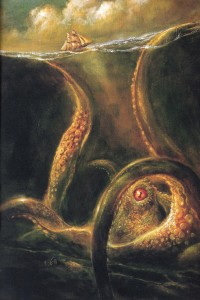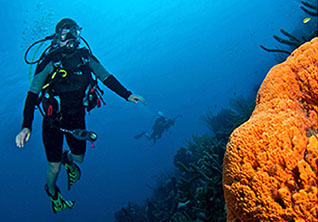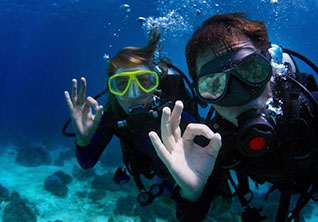It's no secret we love all things ocean and sea legends just come with the territory. This week we are rounding up a few of our favorites: the Kraken, Sirens, and Mermaids. You may have heard of some of these legendary creatures thanks to Disney's Pirates of the Caribbean. If you have kids you can thank SpongeBob SquarePants and Disney for the introduction.
Until we come face-to-face with these creatures, the tales will just have to do although we're not sure how close we would want to get.
Enjoy!
The Kraken

As early as the 13th century sailors have been telling tales of two massive sea creatures one of which was the Kraken. Rumors pointed to sightings off the shores of Norway and Iceland; the Kraken was described in many different ways depending on the era.
The Kraken is incontestably the largest Sea monster in the world with a width of one and a half miles. It was also noted to have had starfish type protuberances: it's arms would be able to get a hold of the largest man-of-war and pull it down to the bottom."
Tall tales of the Kraken grabbing hold of ships with its tentacles and engulfing them from the bottom all the way to its main mast still circulate the seas. Its grip would bring down the ship and its sailors with it and they would be taken by the sea. Kind of like the final scene with Jack Sparrow where the Kraken takes down the Black Pearl.
Cool, huh? But we want nothing to do with it!
Sirens and Mermaids
Beautiful, mysterious, and at times, down right dangerous. Tails (see what we did there) of Sirens and Mermaids have been told by sailors and travelers for centuries; in fact in some languages they are both the same creature.
Sirens

Sirens in Greek mythology were sea nymphs who lived on an island called Sirenum scopuli, but there are different locations depending on the tradition in which the tale is told. These beautiful naiads would enchant sailors and travelers with their siren song and cause them to sail their ships into cliffs and drown.
There were some cases of men thwarting their siren song.
The first were the Argonauts who had Orpheus play a tune louder than the Sirens.
The second was Odysseus’ men who plugged their ears with beeswax. Odysseus alone volunteered to hear the song while tied to the ship’s mast.
This second escape caused the Sirens to kill themselves out of shame. It was then said that Sirens were destined to die should someone hear their song and escape unscathed.
Mermaids

Mermaids, on the other hand, come from mer which means sea and maid(en) which is a legendary creature human from the torso up and fish-like down.
The earliest Mermaid story comes from Assyria around 1000 BCE. Atargatis, an Assyrian priestess, jumped into the sea to wash away her shame of an unwanted pregnancy and emerged as a fishtailed goddess.
Seamen often spotted mermaids during the middle ages. Christopher Columbus among them saw three Mermaids on his first voyage to the Americas in 1493.
Mermaids figured prominently in sailors’ lore, because of such travellers’ tales.
The most common story was that Mermaids were incredibly skilled at seducing lonely sailors and dragging them down to their underwater kingdom. It was also believed that they could cause storms and shipwrecks.
Fun Fact
We are all familiar with Disney’s beloved The Little Mermaid, but did you know how the tale originally came about? In the very first version of the story by Hans Christian Andersen, the mermaid sees her Prince marry a princess and she despairs. She is offered a knife to kill the prince with, but instead she jumps into the sea and dies by turning to froth. Hans Christian Andersen modified the ending slightly to make it more pleasant. In his new ending, instead of dying when turned to froth, she becomes a daughter of the air waiting to go to heaven.

Recent Posts
- Finding the Right Dive Resort For Your Vacation
- Luxury Dive Resorts That Offer Unforgettable Experiences
- Eastern Malaysia, Sabah, Sipadan & More
- Ghost Pipefish, Pipefish, Seahorses, and Sea Dragons
- Australia Queensland and the Great Barrier Reef
- Tioman Islands, Malaysia
- The Riviera Maya
- The Peter Diving System
- The Bay Islands, Roatan, Utila, Guanaja, and more.
- The Cuttlefish; The Undisputed Master of Camouflage.
Categories
- Australia
- Bahamas
- Bay Islands
- Belize
- Blue Hole
- Bonaire Diving
- Borneo
- Cayman Brac
- Cayman Islands
- Cozumel
- Curacao
- Cuttlefish
- Dive Destinations
- Dive Equipment
- Dive Liveaboards
- Dive Resorts / Properties
- Dive Travel
- Dive Travel Deals
- Diver Wellness
- Dolphins
- Dominica
- Eagle Rays
- eagle rays
- Family Travel
- Fiji
- Galapagos Islands
- Great White Shark cage diving
- Guanaja
- Honduras
- Indonesia
- Infographics
- Isla Mujeres
- Learning to Dive
- Little Cayman
- Maduro Dive Newsletter
- Malaysia
- Maldives
- Manta Rays
- Marine Life
- Mexico
- Micronesia
- Muck Diving
- Myamar
- Palau
- Papua New Guinea
- Pelagics
- Philippines
- Pinnacles
- Polynesia
- Reefs
- Riviera Maya
- Roatan
- Saba
- Sabah
- Scuba Diving
- Scuba Gear Reviews
- Scuba News/Events
- Scuba Training & Education
- Sea Legends
- sea lions
- Sea of Cortez
- Sharks
- Single Travel
- Sipadan
- Socorro Islands
- South Africa
- Specialties
- ST. Kitts
- Stingrays
- Tahiti
- Thailand
- The Bucket List
- Tobago
- Truk Lagoon (Chuuk)
- Turks and Caicos Islands
- Turtles
- Uncategorized
- Underwater Photography
- Underwater Video
- Utila
- Walls
- Whale Sharks
- Whales
- Wreck Diving
- Wrecks
- Yap
Archives
- June 2025
- January 2024
- April 2023
- March 2020
- March 2019
- January 2019
- November 2018
- September 2018
- July 2018
- May 2018
- March 2018
- January 2018
- October 2017
- September 2017
- June 2017
- April 2017
- February 2017
- January 2017
- October 2016
- August 2016
- July 2016
- May 2016
- March 2016
- February 2016
- January 2016
- December 2015
- August 2015
- June 2015
- April 2015
- January 2015
- November 2014
- July 2014
- April 2014
- February 2014
- December 2013
- November 2013
- October 2013
- September 2013
- August 2013
- July 2013
- June 2013
- May 2013
- April 2013
- March 2013
- February 2013
- January 2013
- December 2012
- November 2012
- October 2012
- September 2012
- August 2012
- July 2012
- June 2012
- May 2012
- April 2012












